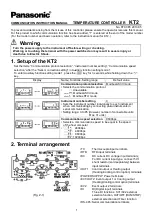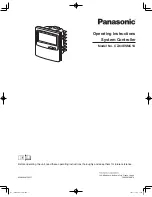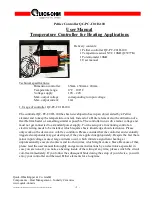
18
SPECTRA COMMERCIAL AND RESIDENTIAL INSTALLATION GUIDE
9)
Initiate a control signal to place the unit in the heating mode. Heating set point must
be set above room temperature.
10) First stage heating will energize after a time delay.
11) Check the temperature of both the supply and discharge water. Refer to Table 2 on
page 17.
12) Check for an air temperature rise of 20
°
to 35
°
F across the air coil, depending on the
fan speed and entering water temperature. Refer to Unit Operating Pressure on
page 13.
13) If auxiliary electric heaters are installed, adjust the heating set point until the electric
heat banks are sequenced on. All stages of the auxiliary heater should be sequenced
on when the thermostat is in the "Emergency" Heat mode. Check amperage of
each element.
14) Adjust the heating set point below room temperature and verify that the compressor
and water valve or loop pumps deactivate.
15) During all testing, check for excessive vibration, noise or water leaks. Correct or repair
as required.
16) Set system to desired normal operating mode and set temperature to maintain desired
comfort level.
17) Instruct the owner/operator of the proper operation of the thermostat and system
maintenance.
18) During all testing, check for excessive vibration, noise or water leaks. Correct or repair
as required.
19) Set system to desired normal operating mode and set temperature to maintain desired
comfort level.
20) Instruct the owner/operator of the proper operation of the thermostat and system
maintenance.
NOTE: If performance during any mode appears abnormal, refer to the troubleshooting
section on page 19.
Water Coil Maintenance
1)
Keep all air out of the water. An open loop system should be checked to insure that the
well head is not allowing air to infiltrate the water line. Lines should always be airtight.
2)
Keep the system under pressure at all times. It is necessary in open loop systems that
the water control valve be placed in the discharge line to prevent loss of pressure
during off cycles. Closed loop systems must have positive static pressure or air vents
may draw air into the system.
NOTE:
If the installation is performed in an area with a known high mineral content (125
P.P.M.or greater) in the water, it is best to establish with the owner a periodic maintenance
schedule so the coil can be checked regularly. Should periodic coil cleaning be necessary,
use standard coil cleaning procedures which are compatible with either the cupronickel or
copper water lines. Generally, the more water flowing through the unit the less chance
for scaling.
Other Maintenance
Filters - Filters must be clean to obtain maximum performance. They should be in-
spected every two to three months under normal operating conditions and be replaced
when necessary. Units should never be operated without a filter.
Preventive
Maintenance



































